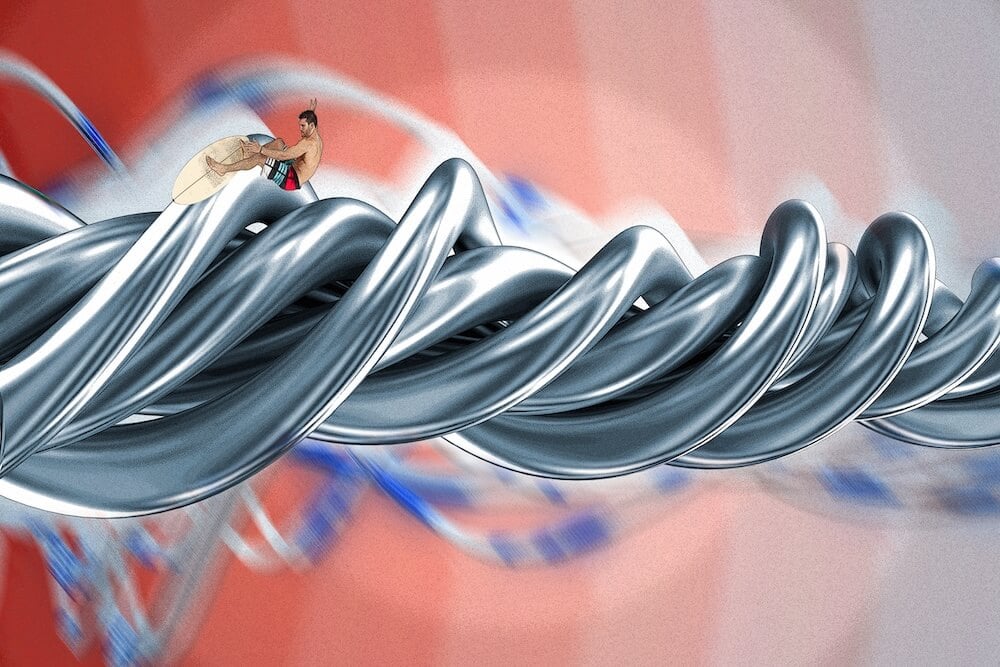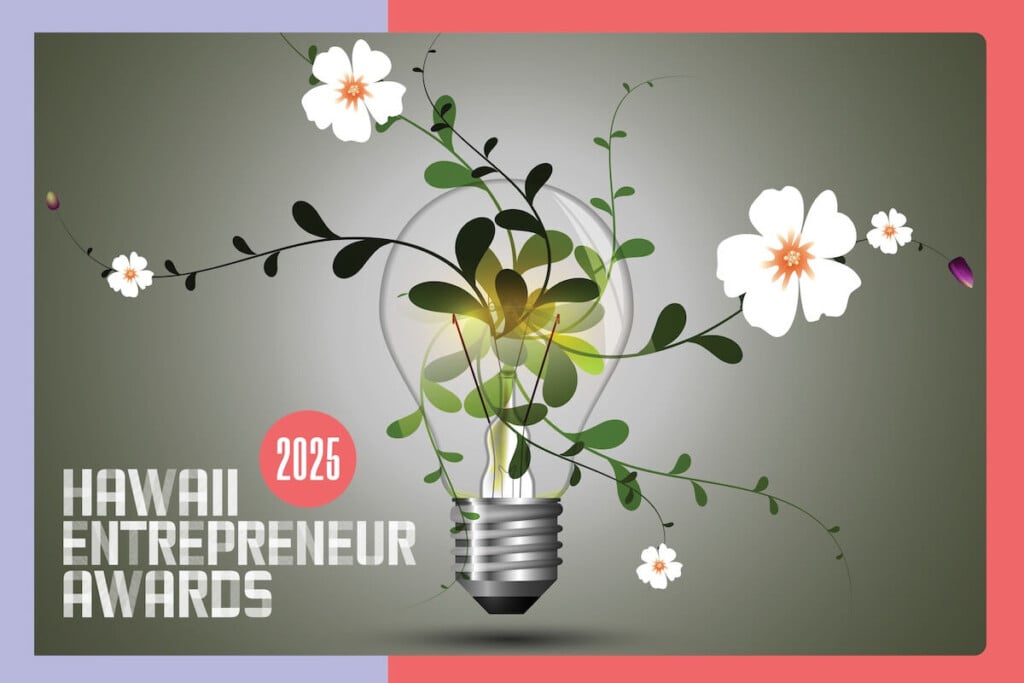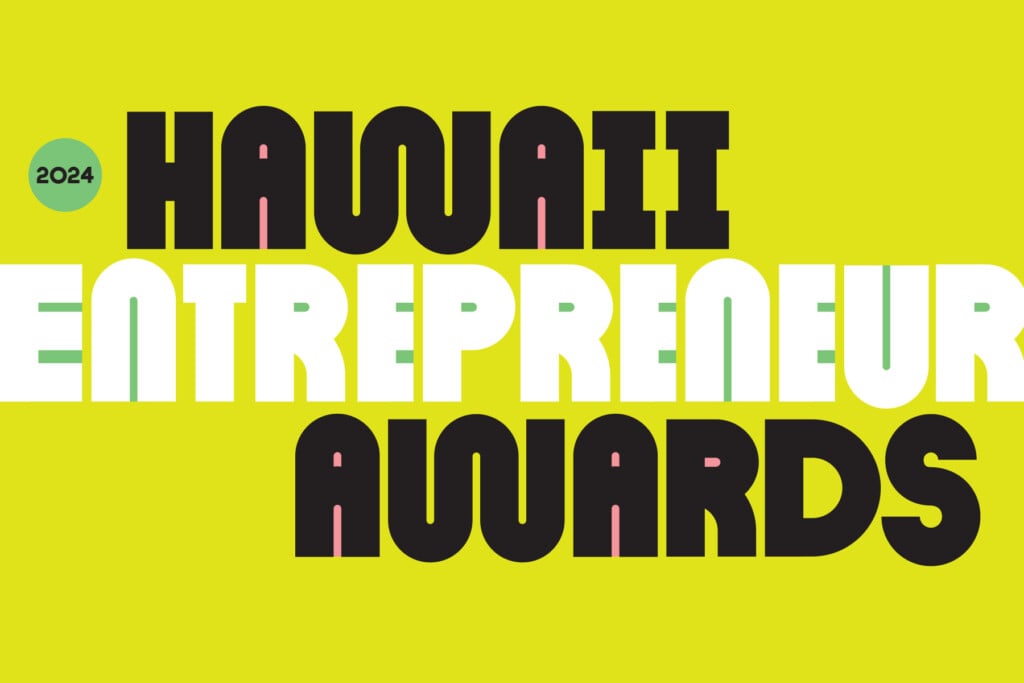Hawaii: Headquarters of the Future

Richard Kaipo Lum has had plenty of clients that you’ve heard of. To name a few: the European Commission, the city of Stockholm, the governments of Canada, the United Kingdom and Singapore, along with multinationals like PepsiCo, IBM and others he isn’t allowed to name. Lum has even briefed a national security team at the White House.
You may never have heard of his profession, but even if you have, I bet you didn’t know Hawaii is considered a global center of excellence in his field.
Lum is a futurist, helping governments, companies, communities, and other organizations navigate an economic, political and social landscape of increasing complexity, proliferating technology and rapid change. Some clients are small: he’s worked with Kanu Hawaii and the Hawaii Community Federal Credit Union. Lately, most have been much larger.
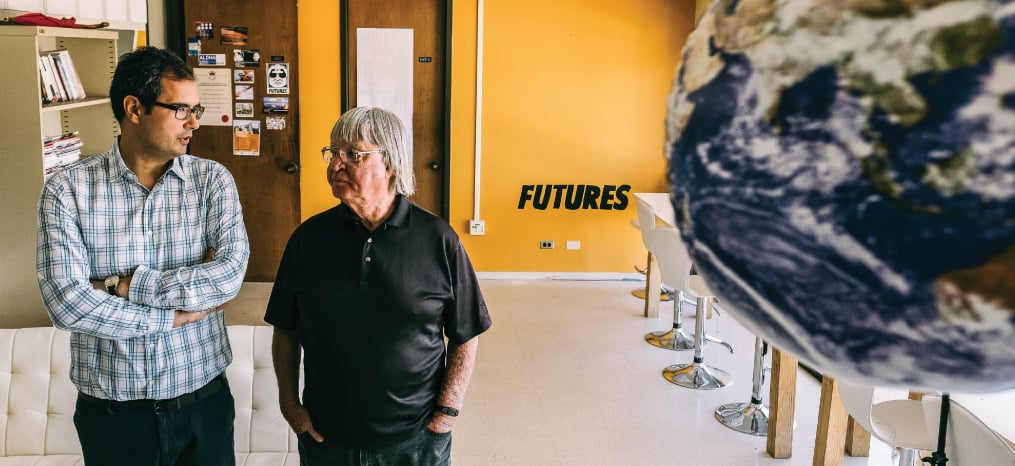
As a profession, futures studies is taking off across the globe, as demand for futurists increases. “Almost every nation in the world has some kind of foresight activity in their government,” says Jim Dator, founder of UH Manoa’s Hawaii Research Center for Futures Studies, also called Hawaii Futures.
The center “really has a pretty long-standing global presence,” says Jairus Grove, the center’s director, adding that there’s “a real futures renaissance.”
“Almost every nation in the world has some kind of foresight activity in their government.”
—Jim Dator
Founder, Hawaii Research Center for Futures Studies
Aubrey Yee, a PhD candidate and futurist with the UH center, thinks she knows why, after decades of steady but under-the-radar work, demand is rising. “The pace of change is making people nervous. The complexity of the world, and technology, are moving at a very fast pace. Think about all the changes that have happened in the last 50 years – it’s exponential. And it’s big stuff that’s changing, things that are fundamental. There’s an uneasiness around that.”
Grove agrees. “We’ve never been so desperate for new ideas. We now have challenges at a scale we’ve never had before.”
If you wonder how you or your organization can plan for the future, Grove describes the center’s work as “a kind of future-proofing.”
“You can’t actually predict the future,” he says. “What you can do is put pressure on the present.”
To put pressure on the present, you have to envision what might happen, and where you want to end up. That’s where a futurist comes in.
“Before you plan, you should dream,” says UH futurist Mary “Tuti” Baker. “That is the key to resilience: to immerse yourself in, say, what might be a scary future, and to realize there is a resilience, there, within the group, to thrive.”
The Ridiculous Science
Futurists are different from planners and strategists in their scope and timescale (although many futurists also do planning and strategy work). Administrators, says Baker, concentrate on the present, and have immediate, limited goals: “When they sit down in that administrative chair, they have to make sure that everything is working now. And that’s good.” Planners have a longer horizon (usually 5-10 years) and broader goals, but they are still operating in a mainstream realm, with set current conditions and goals that are readily apparent to everyone.
Futurists, on the other hand, have a timescale that starts where planners and strategists leave off. The working time frame of futures studies extends way over the horizon, where, by looking at certain drivers of change – political, social, economic, environmental, technological – they try to anticipate large-scale developments that are not already top-of-mind. It’s not uncommon for them to think about what’s going to be happening a century from now, and walk clients through brainstorm sessions on how they can create structures and policies that will remain robust through those changes.
In other words, futurists must operate in the realm of the seemingly nutty. Dator likes to remind his students that “Any useful statement about the futures should appear to be ridiculous.” Jesse Souki, who has a master’s degree in alternative futures from the UH center and is currently the director of Planning, Permitting and Right of Way at the Honolulu Authority for Rapid Transportation, gives an example of how seemingly improbable has a habit of becoming reality: “Think about someone in the 1960s being told that we’d be using a computer on our wrist with the same computing power of a 1960s mainframe.”
“It’s easy to be silly about futures,” admits Grove. “We assume futurists are people with crazy hair, talking about things that will never happen.” But “to do the job right, you have to live way out over the horizon,” says Lum. “You’re trying to have a look at the dark spaces, trying to anticipate outcomes nobody’s worried about yet, to anticipate change before it happens.”
Lum calls it the “futurist’s curse.”
“If you are doing your job well (as a futurist), you are in fact always struggling to pull somebody’s attention a little farther into the future than they want to be.”
—Richard Kaipo Lum
Founder, Vision Foresight Strategy LLC
“It’s not that no one believes you, it’s just recognizing that if you are doing your job well, you are in fact always struggling to pull somebody’s attention a little farther into the future than they want to be. It’s always an effort. It’s always an uphill battle” to communicate the inherent value.
“The curse comes,” says Lum, “when what you were talking about finally becomes mainstream and everybody says, ‘Oh my God, we have to pay attention to this.’ People will be making fortunes on the lecture circuit talking about it. But you’re going to be like, ‘Yeah we were talking about this 10 years ago.’ And you’ll be thinking about something else. If you don’t realize that as a risk of your profession, you’re going to be very frustrated,” he laughs.
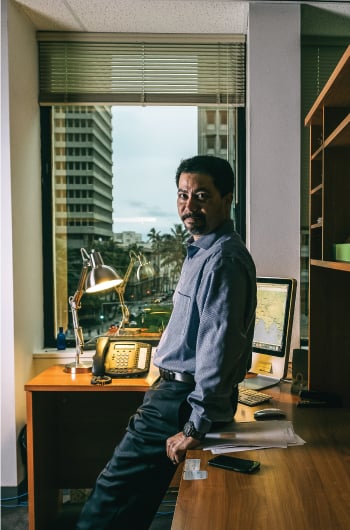
Richard Kaipo Lum says that to do the job right, futurists “have to live way out over the horizon. You’re trying to have a look at the dark spaces, trying to anticipate outcomes nobody’s worried about yet, to anticipate change before it happens.”
Hawaii Futures client Mike Seyle, president and CEO of global architecture firm WATG, which was founded in Honolulu 71 years ago, explains it this way: A futurist can “open your eyes to the idea that you can anticipate what goes on in the future a little bit. It’s like your drive to work. The very first time you drove to a new job from home, you were looking at every corner, every street sign, every new building, to create landmarks to remember how to get home. You do that 10 times, it gets a little easier, and the 100th time, it’s ‘I don’t even remember driving today.’ That’s your body and mind getting used to the signposts, every day. By now, you could close your eyes and imagine every bit of your drive to work. That’s what futurists do. Every day, they think a little farther into future and come back. A little farther, and come back. And signposts start to develop.”
Seyle admits that long-term thinking about a future that’s markedly different from the present is not necessarily intuitive: “It’s hard to get too far out without thinking, ‘This is silly.’ You lose confidence. Until you’ve done it a few times, and [looking back] you realize, ‘Wow, I wasn’t far off.’ “
“This exercise isn’t guessing or soothsaying,” says Jesse Souki, who worked with a team of Hawaii futurists when he was director of the state Office of Planning and the office was creating the state’s climate change plan in 2012. “There are several methodologies for considering alternative futures that are recognized academically and by respected organizations like National Intelligence, the CIA and Rand Corp.”
What Futurists Do
Let’s get this out of the way: A good futurist will not tell you the future. They don’t know it. “A good, professional futurist is not going to talk about what the future is going to be,” says UH-trained futurist Aaron Rosa. “A good futurist should say, ‘I don’t know what the future is going to be, but we can find out about what the futures might be, and talk about what you want the future to be, and think about how we can get there.’”
Within that framework, there are many approaches. Many clients start out with what they know: they ask for a report. But there’s a problem with that method, says Rosa: The over-the-horizon nature of futures studies means that “reports just go on bookshelves and gather dust.” More active approaches work better, says Grove, including immersive experiences, interactive workshops and games.
He says the goal is to teach people a mindset they can take anywhere. “We like to work with (clients) to develop techniques that they can build into their year-after-year process, so that report doesn’t sit on a shelf somewhere and never get used. Then, in a perfect world, they’d never have to hire us again, because they’d build futures into their own strategic planning.”
One of the most common futures techniques, in part because it can be implemented in as little as a half day, is the “four futures” workshop, an imaginative, facilitated walkthrough of four possible futures, based on parameters provided partly by the client and partly by the futurist. Under the alternative futures method, which Dator created, the futures are:
• Continued Growth: All of today’s trends continue steadily into the future;
• Collapse: A Jared Diamond-type scenario in which limits of growth are overstepped and the landing is hard;
• Discipline: The group foresees the limitations before they are reached and takes action; and
• Transformation: Technology or other factors redraw the boundaries of what’s possible.
“We want everybody to be exposed to four archetypal images of the future that are very different,” says Baker.
“Then we want to give people time to explore those and reflect. And always, at the end, there should be time dedicated to thinking, ‘OK, none of those futures is the future. But now that you have the holistic idea of what the future could be, what do you want it to be?’ That’s where the great work starts. You start making new decisions.
What is your plan going to be? It gives people a feeling of control back, a feeling that they are still in the driver’s seat.”
Or you might play a game. Rosa specializes in futures-oriented role-playing games, which are serious business; they’re used to unify diverse stakeholders, get them to face and discuss potentially scary or threatening topics, and help people make imaginative leaps. They can also level a playing field, says Grove, and help to include diverse and nonexpert voices. “Part of futures is creating environments where people’s expertise doesn’t become weapons and defenses. How do you get people to talk outside their comfort zone?”
How can you achieve all this with a game? Rosa explains an old gaming concept: “the magic circle.” Inside it, says Rosa, there’s a “safe space to have these discussions. Everybody is a little more free to say what they think and how they feel,” because they’ve all agreed to inhabit a role. “Players can pop into a role they’re totally unfamiliar with and begin taking on, what does it mean to live in that (role)? To think, to strategize, to plan?”
Just how high the stakes can be in futures gaming was clear at the 2014 Tonga foresightXchange, which the United Nations asked Rosa and Baker to help facilitate. Rosa was told it was the first time since transitioning to a constitutional monarchy (rather than an absolute one) that Tongan civil society had been convened in that way.
Although low-lying Tonga faces multiple threats from climate change, a futures approach allowed the discussion to go beyond doom and gloom, says Grove, and the conversation moved to options that might preserve Tonga’s identity: “Should we all meet in one place? Should Tonga become part of Australia but buy some land? Should we never all meet back up, but maybe are there cultural practices we want to maintain? It takes the sting out of climate change, if there are ways to persist, rather than merely being destroyed.”
There were multiple stakeholders in the room that day, recalls Rosa, and “in terms of opening up conversations, that was a fantastic project. There were over a hundred people who came from all walks of life. Watching them talk about long-term issues that faced their very small island community, that was amazing.”
“A lot of the work happens once you bring out all these different futures and get people talking. All of a sudden, the ideas of the future that everybody has in their own head emerge and make a conversation that wasn’t there before.”
—Aaron Rosa
Founder, Rorosoro LLC
A futures approach “gave them confidence in the face of uncertainty,” says Rosa. “We want them to walk away saying, ‘OK, we can still have a sense of identity – of who we can be, and who we are –and we can craft that … A lot of the work happens once you bring out all these different futures and get people talking. All of a sudden, the ideas of the future that everybody has in their own head emerge and make a conversation that wasn’t there before.”
Games can also test drive policies, using real players with opposing priorities and goals to spot loopholes and other ways to turn the system to their advantage (in game parlance, “exploit”). Jesse Souki, who used futurists to help the state plan for sea-level rise, thinks a futures approach lets policymakers create “robust” policies that will stand up to unforeseen developments. “The alternative futures approach should be the first approach to all policy development,” Souki says.
If that sounds a little outside the box, says Grove, consider that nations like Finland and South Korea “already have divisions of their legislative body which require they have a futures means test for whatever they’re going to do.”
Futures games also create an almost magical sense of shared community, says Rosa. “I don’t know what it is about games. There’s some innate quality of play. When people start playing they enter this space … they get serious about it. When a scientist (is assigned to be a policymaker), they’re writing all the policies they think should have been written in the first place. They also see how difficult it is for a policy to appease everybody. Emotions tend to run high, but in a good way. It’s inside the magic circle.”
Another product of futures games is empathy, says Rosa. “That’s one of the challenges we face in Hawaii: ‘Things are tough already, so don’t ask me to think about how somebody else feels, or acts.’ Being asked to take on that additional challenge and responsibility, that’s not comfortable for everybody. But if you get everybody inside that circle, you say, ‘OK, this is a different world.’ And if you create a new level of comfort, maybe you can open up a new discussion. Maybe you can have a reset on some of those relationships between people, places, institutions. Maybe you can break that ice – or that concrete.”
A Business Application
Economic times, they are a-changing, and “we feel it,” says Lum. “You can’t keep your business model together as long as you could before.” That may be why, as Dator says, “many businesses, especially big businesses, are heavy consumers of futures information.” Disney, PepsiCo, Google, Chevron, Shell, Procter & Gamble, Intel, General Motors and Ford are all multinationals said to work with independent or in-house futurists. Even chocolate-maker Hershey’s was recently looking to hire a senior manager in foresight activation. But because so much for-profit futures work is proprietary, it’s hard to get a bead on exactly how much of it there is.
One business that has embraced futures studies is WATG, born in Honolulu in 1945 and now headquartered in London, having grown into the world’s leading resort and destination design firm. In 2014 and 2015, WATG hired the Hawaii Futures team, which included Dator, Rosa and Baker, to facilitate workshops for its worldwide regional management groups, including a meeting of the board of directors in Honolulu.
Futurists immersed the WATG groups in four possible scenarios and reconvened them to think about ways they could respond to each. Although none of the four scenarios contains everything that will play out, Rosa calls the group’s willingness to get creative about the ways they might not only survive, but thrive, “inspiring. They jumped in with both feet.”
CEO Mike Seyle says that through their work with Hawaii futurists and other forecasters, the company’s leaders have built long-term thinking into their annual process. One forecasting tool they use is the S-curve, a way to conceptualize where a given factor might be in its growth cycle. Twice a year, the board meets to plot various indicators, “and pretty quick,” says Seyle, “you think, ‘Wow, I have an idea of where we are, and I can see where we are going. Let’s put our resources into the model that’s going up, and pull them out of the model that’s going down. That’s how you can apply what futurists do. Once you’ve figured out where the hurricane’s going, you can plan.”
Taking a long-term view, and treating every WATG employee’s career as an S-curve cycle, has also helped WATG weather a potentially catastrophic shortage of middle-generation talent that Seyle ascribes to the layoffs during the latest recession. “We have very senior people and very junior people, but the people in the middle, they went and found something else to do. We have fewer people in their 40s. I’m sure we’re not the only ones with a talent gap, but we wouldn’t even know it was there if we hadn’t plotted it on the graph.”
Having identified its middle management gap, WATG could manage it before it became a crisis. “We could have gone out and tried to hire expensive managers,” says Seyle, but instead “flattened our organization. We called it distributing control down.” WATG gave junior staffers the authority to make decisions that managers would have made for them in the past, and the benefits have been twofold: not only are the Millennial staffers being “developed faster,” according to Seyle, but “it made them pretty happy.” Hospitality Design magazine recently named WATG the “Best Design Firm to Work For” globally.
Futures studies can be “a hard thing to sell,” says Grove. “It doesn’t have an immediate metric for how you’re going to do on the market.” But he emphasizes that a flexible futures mindset can create long-lasting value. “It’s trying to get people to think about all those possibilities, so they don’t build a system that is useless when that one particular future doesn’t pan out. When you focus on process, it builds adaptation into the system: How do you create a preferred present that prepares you to adapt for the future?”
Souki, the former director of the state Office of Planning, agrees. “Most change is not within our control,” he says, but “how we respond or plan for change, is within our control.”
Yee, the futurist, adds, “We throw things in the trash that are going to be around in 200 years; we’re already inhabiting the future without thinking about it. Let’s be more mindful of it … because if we’re not consciously, collectively, creating our future, someone else is going to do it for us.”
The Founder of Hawaii Futures
One of the first things you see on the door of the Hawaii Research Center for Futures Studies at UH Manoa is a black and white graphic poster of Jim Dator, the center’s founder. Dator, who came to Hawaii after teaching for many years in Japan and on the Mainland, is often described by his contemporaries as “one of the fathers of futurism” in the United States. “In the world of futures, Jim is extremely highly regarded,” confirms futurist Aubrey Yee, one of his students. “But he’ll never tell you that.”
In more than two hours of conversation, he doesn’t. But the U.S. Forestry Service does. When they needed a team of futurists to consult on a biocellular nanotechnology project, says research forester David Bengston, it called on Hawaii Futures so the Forestry Service team could “learn firsthand from one of the world’s most prominent futurists.”
So why haven’t we heard more about Dator and the center, which was the first of its kind in the U.S.? In part, it’s old-fashioned modesty, the kind you don’t see often in the age of social media; Dator says that while “there’s no shortage of people who are asking me and others to work with them – it shows there is a need – many people, like you, aren’t aware that there is this organization here.” Why not? “I haven’t felt I ought to advertise. It didn’t seem quite right.”
The center is still one of only a handful of places in the world that you can get a PhD in Futures Studies, says Yee, and “the graduates go around the world and do amazing things. It’s a really undersung resource.”
“It’s weird that way,” agrees Aaron Rosa, a locally based futurist whose clients have included the Macedonian government, the European Union’s Joint Research Centre and the United Nations Development Programme, but could only recall a single Hawaii-based client when asked.
Jesse Souki notes that the center was actually established by the state Legislature in 1971. “It’s a resource available to government,” says Souki.
Jairus Grove, the center’s current director, emphasizes that its first mission is “to be responsive to the community of Hawaii.” Providing those resources to the rest of the world comes second – but it’s the rest of the world that has been knocking.
Go Figure: World Powers Are Not Big Fans
Many national governments consult futurists, but the 800-pound gorillas in the room don’t, much: the United States (except the Department of Defense), Russia, and China.
The reason is easy to see, says Jim Dator: “If you are vulnerable, then you have to pay attention to what is happening.”
The flip side is that giants sometimes don’t anticipate what’s going to happen until it’s too late. “Corporations do that all the time,” says Jairus Grove. “Just ask Kodak.”
Grove, invoking political theorist Karl Deutsch, says power, in part, “is the material capacity not to learn. If you are powerful enough, you can ignore good advice and changes in the outside world. Not being willing to adapt is a luxury.”
Grove offers South Korea as an example of a government, keenly aware of its vulnerability, that works closely with futurists. “South Koreans have this saying: ‘a shrimp between two whales,’ ” says Grove. “I laughed when I heard that. They have China on one side and Japan on the other. They have to be smart, because the penalties for failure are extremely high.”
Although Hawaii is part of a large nation, physically and geographically, the state itself is a small place. We have fewer resources, a smaller market and things take longer to reach us than most of America. We feel that smallness and isolation every time we click “buy” but the online retailer refuses to ship to Hawaii.
Our smallness also makes us more vulnerable to world events, says Grove. “We are unfortunately at the forefront of all the worst problems of the world: of climate change, pandemic disease, the eccentricities of economic globalization. It’s part of island living. Small changes have big consequences.”
But vulnerability can keep us alert, says Dator. “We are one of the first states to take sea-level rise seriously, whereas in the state of North Carolina, it’s illegal to use forecasts of sea level rise in order to make coastal-zone decisions. You can only use historical data.”
“In a perfect world, we want a government to have the fleet-footedness created by precarity, without having to be precarious,” says Grove. “That’s the challenge. How do you learn to have the sensitivity you have because you’re fragile, before you’re fragile?”
Different Futures, Different Futurists
Futures studies is undergoing a generational shift, as first-wave futurists such as Jim Dator retire and cede the field to Gen-Xers and Millennials, whose world-views are very different. In the past half century, popular images of the future have also changed, from the Jetsons and Star Trek to possible pandemics, climate change and the dystopian sci-fi series Black Mirror.
“There used to be a notion of progress: It’s all going to be good, this upward line,” says Lum. “Today, that has been completely undermined for most people who are thinking about it. There’s a much more critical view that’s seeping across the mainstream. More and more people assume there will be a tradeoff: If we set these nanobots out into the world, how will that bite us in the butt? It’s more critical. And that’s good.”
A Peek into the Futures
From a futurist’s perspective, if it doesn’t sound way out there, it’s not useful. Richard Kaipo Lum recalls a lunch meeting with some Honolulu-based bankers who were “very polite but totally not interested” that he thought crowdfunding might become influential in the finance world. One of his lunch partners told him, ‘When they crowdfund a real estate development, come talk to me.” Headline from Forbes.com in December 2015: “How Crowdfunding Has Changed Real Estate Investing.”
Here are three wacky-sounding developments that you may hear much more about in the future:
• Business: Decentralized Autonomous Organizations, also called Fully Automated Business Entities. These cloud-based companies, fully staffed by software, are based off blockchain technology, which investor Marc Andreessen described in the New York Times as “a way to exchange money or assets between parties with no pre-exisiting trust.” Lum thinks an early application might be self-executing financial transactions like “digital escrow,” in which software-staffed holding companies can serve as “a third party that’s not going to go anywhere (with the money). And nobody can renege.”
• Government: More direct democracy. Participatory budgeting, which is being tried in more than 1,500 municipalities across the globe, gives communities a more direct say in how their tax dollars are spent. Residents directly vote to allocate part of the city’s funds. Tech tools are not required, but several wards in Chicago use Google Apps to invite their voters to allocate about $5 million in total public funds each year.
Why stop there? asks Lum. A technological environment in which everybody can weight in almost instantly about anything means that all types of direct democracy more practical. Our founding fathers put power in the hands of elected officials, but, in 1776, it was “impractical and impossible” to constantly assemble citizens for decision making, especially in rural areas. Says Lum: “Technology today gets you into the zone where you can start to think about constructing actual (direct) democracy. Not that you’d necessarily want to all the time – but you can.”
• Climate: Geoengineering. This sounds like it’s ripped straight from the big screen, but, in a small sense, the human race has been geoengineering for centuries, says Jairus Grove. He points to the Netherlands, where one-quarter of the land is below sea level and sustained by an extensive system of dykes, dams and dunes. But these days, geoengineering is defined more narrowly; the Oxford University Geoengineering Programme defines it as “the deliberate large-scale intervention in the earth’s natural systems to counteract climate change.”
One much-talked-about form of geoengineering is Solar Radiation Management, and one of its methods aims to regulate temperature rise by injecting the upper atmosphere with tiny sulfate particles that would bounce back some of the sun’s energy. A side effect, reported by Scientific American, is likely to be whiter skies. The subject is still controversial, but Grove says the conversation has evolved in recent years to the point that “Geoengineering is becoming a kind of consensus. It’s going to be something we’re going to have to do.”
Aubrey Yee suspects we’ll start to hear a lot more about geoengineering and other once-unthinkable interventions in the near term, as these approaches move out of think tanks and universities and into the realm of policy: “As we start to see more results of climate change, and start to see the pressures of that, we’re going to be pushed to embrace these dramatic technologies faster.”
Futures: Why the S?
The term “futures studies” always comes with an “s” at the end of future, to emphasize that possibilities are plural.
